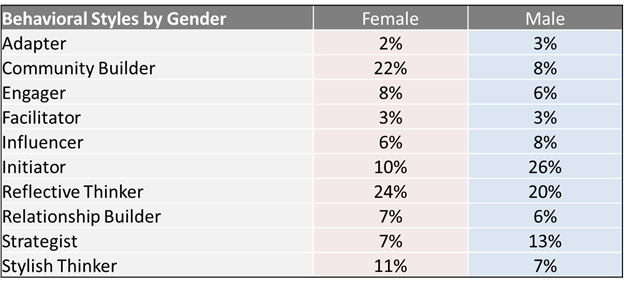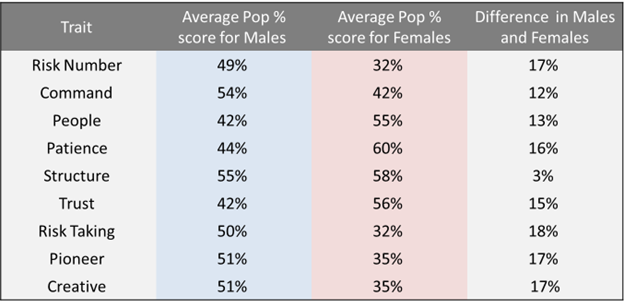Recognizing Gender Differences: The Importance of Tailoring Professional Approaches
The analysis of behavioral data from 65,000 individuals revealed that men and women demonstrate varying approaches to work, life, relationships, and investing. Explore the behavioral science research.
As human beings, it's no secret that men and women possess inherent biological and psychological differences. These dissimilarities, although not absolute, can play a significant role in shaping individual behavior, preferences, and communication styles. Recognizing and understanding these distinctions can be crucial in various aspects of life, including the professional sphere. So, we examined the behavioral data of 65,000 randomly selected individuals to analyze so that we could learn more. Let’s delve into what we discovered about the importance of catering to the divergent needs of men and women, backed by these insights from DNA Behavior's Natural Behavior Discovery Process.
The Power of Understanding Gender Differences
While it is essential to acknowledge that each individual is unique and cannot be solely defined by their gender, scientific research has consistently highlighted patterns and tendencies that distinguish men and women. These differences manifest across various domains, such as communication, work talents, leadership style, decision-making, financial behavior, problem-solving, work-life balance, and interpersonal relationships. Understanding these variances allows professionals to optimize their interactions and tailor their approaches accordingly.
Communication Styles
Communication is a fundamental aspect of any professional setting. Men and women often exhibit differing communication styles, which can impact how they perceive and convey information. For instance, studies have suggested that women tend to be more empathetic and nurturing in their communication, emphasizing collaboration and building rapport. Men, on the other hand, may focus on hierarchy and assertiveness, often seeking to establish dominance or convey confidence. Recognizing these differences can help professionals adapt their communication strategies to foster effective and inclusive dialogue.
Work Talents
Men and women often bring distinct work talents to the table. In problem-solving, men may adopt authoritative and results-oriented approaches, taking charge and seeking imaginative solutions, while women may tend to rely on experiential knowledge and collaborative decision-making relying more on their relational side. Embracing these disparities can foster more well-rounded leadership teams, innovation, and organizational success.
Leadership Styles
Effective leadership entails understanding and responding to the needs of diverse team members. Men and women tend to demonstrate divergent leadership styles, each with unique strengths and perspectives. Women leaders often excel in fostering collaboration, empathy, and inclusivity, while men may lean towards assertiveness, strategic thinking, and risk-taking. When these divergent styles are encouraged and respected, leaders can be more effective by leaning on what comes naturally to them.
Decision-Making Processes
Men and women often exhibit varying decision-making processes due to their distinct psychological tendencies. Research has shown that women may rely more on intuitive and holistic thinking, taking into account emotions and considering a broader range of options. In contrast, men tend to lean toward logical and analytical decision-making, prioritizing facts and objective data. By understanding these tendencies, professionals can structure decision-making processes that encompass both rational and emotional factors, allowing for a more comprehensive approach.
Financial Behavior
When it comes to the overall financial personality, certain general trends have been observed between genders. Women often exhibit a greater inclination towards planning and structure in their financial decisions. They tend to prioritize long-term financial goals and are more likely to engage in cautious and calculated investment strategies. On the other hand, men tend to display a higher propensity for risk-taking in their financial pursuits. They are more inclined to explore high-risk, high-reward investment opportunities and may be more willing to embrace uncertainty in search of potential gains. Accepting that each approach adds a valuable dimension to the financial decision-making process is key to attaining better outcomes overall.
Work-Life Balance
Balancing personal and professional responsibilities is a challenge faced by both men and women. However, societal expectations and gender roles can influence the way individuals prioritize their work-life balance. Men may face pressure to prioritize their careers, while women may feel torn between professional aspirations and familial obligations. Creating a supportive work environment that acknowledges and accommodates these differences is crucial for fostering employee satisfaction, engagement, and overall well-being.
Problem Solving
Men often lean towards authoritative and creative approaches, taking charge and seeking innovative solutions. In contrast, women tend to rely on experiential knowledge and collaborative decision-making, valuing diverse perspectives and inclusive solutions. A conscientious combination of these approaches can benefit problem-solving and decision-making effectiveness.
Interpersonal Relationships
In many social and relationship contexts, men tend to exhibit a more task-oriented approach, focusing on achieving specific goals and outcomes efficiently. They may prioritize the completion of tasks and direct their energy towards achieving tangible results. On the other hand, women often demonstrate a greater emphasis on patience, fostering relationships, and collaborating with others. They may prioritize building strong connections and working harmoniously in a team to achieve collective success. Recognizing and valuing both task-oriented and relationship-oriented approaches can lead to more balanced and effective outcomes in any number of settings.
Overall Differences Between Men and Women
The DNA Natural Behavior Discovery Process has been scientifically validated to measure natural DNA behaviors with a 97.1% reliability level. To learn more, please review our research and methodology under the About Us section of our website.
This graphic of our research results highlights how men and women are different across the ten core DNA Unique styles measured by the DNA Behavior Discovery Process.

*The men, on average, more frequently show up in the following styles, indicating they are more results-driven: Adapter, Influencer, Initiator, Strategist
*The women, on average, more frequently show up in the following styles, indicating they are more relationship-driven: Community Builder, Engager, Reflective Thinker, Relationship Builder, and Stylish Thinker.
While there are some differences shown between men and women in the results, the design of the DNA Natural Behavior Assessment is intended to be gender-neutral. This is achieved through the singular word phrasing used in the Forced Choice Scoring Model. So, while gender differences exist between men and women, that outcome is not driven by the assessment process itself. Rather, it purely reflects the natural behavior differences of men and women.
Opposites Attract Theory
As highlighted in the graphic below, married couples are on average 29-35% different in terms of their population-weighted scores on each of the eight DNA Factors. That confirms that opposites attract in marital relationships!

Insights on Key Areas Where Men and Women Show Differences
In analyzing a sample of 65,000 men and women, the DNA Natural Behavior Discovery Process has provided insights into key areas where they demonstrate differences:
- Risk Factor: Men exhibit a 17% higher propensity to take risks than women. Although, women are far more cautious with an overall population-weighted Risk-taking score of 32% compared to men of 49%. This suggests that men may be more inclined to take risks, which can be considered when designing projects or assignments requiring calculated risks and making financial and investment decisions.
- Command Factor: Men show a 12% higher inclination towards asserting command. Although, women are more cooperative with an overall population-weighted Command score of 42% compared to men of 54%. This highlights men’s potential for leadership roles that require more authority and direction, allowing professionals to recognize and provide suitable opportunities for men to thrive in such positions. However, it also highlights that women will adopt a more collaborative leadership approach.
- People Factor: With a 13% difference, men may tend to prioritize reflection time and tasks over building interpersonal relationships. In this regard, women are more outgoing with an overall population-weighted People score of 55% compared to men of 42%. This indicates the importance of creating a balanced environment that values both task-oriented and people-oriented approaches to foster effective collaboration.
- Patience Factor: With a 16% difference, women exhibit far more patience, feelings, and desire to build relationships compared to men. In this regard, women are more Patient with an overall population-weighted score of 60% compared to men of 44%. Acknowledging this variance can help people balance out the drive for results versus relationships. Managing both the drive for results and the people culture are important for ensuring optimal productivity and job satisfaction.
- Structure Factor: With a 3% difference in their preference for structure, women are slightly more planned than men. In this regard, women have a population-weighted Structure score of 58% and men have a score of 55%. This implies that they both may benefit from clear guidelines and well-defined frameworks in their professional endeavors, enabling them to excel in environments that provide structure and organization.
- Trust Factor: With a 15% difference in trust behavior, women are more trusting than men, who may be more skeptical and, therefore, may approach trust-building differently than women. In this regard, women have a population-weighted Trust score of 56% and men score 42%. Recognizing this disparity can help professionals implement strategies that foster trust and establish strong relationships within teams and organizations.
- Pioneer Factor: With a 17% difference in their pioneer behavior, men are more goal-driven and competitive than women who are more content. In this regard, men have a population-weighted Pioneer score of 51% and women score 35%. This suggests that men are inclined to explore uncharted territories, which can be channeled to drive entrepreneurial pursuits and innovation, and cultivate a spirit of exploration within organizations.
- Creative Factor: With a 17% difference in creative behavior, men are more imaginative and enterprising than women. In this regard, men have a population-weighted Creative score of 51% and women score 35%. This suggests men may exhibit more unique perspectives and approaches to creativity. Incorporating diverse perspectives in creative endeavors can foster a rich and varied output that benefits both individuals and the organization as a whole.

The acknowledgment of gender differences in the professional sphere is not about perpetuating stereotypes or promoting inequality but rather about recognizing and respecting the inherent dissimilarities that exist. Our analysis provided valuable insights into the diverse needs of men and women, reinforcing the significance of tailored approaches. By understanding and embracing these differences, professionals can create inclusive environments that maximize the potential of both men and women.
As professionals, we have an opportunity to harness the power of gender diversity, leveraging the strengths and perspectives of both genders. By adapting communication styles, decision-making processes, leadership approaches, and work-life balance strategies, organizations can foster greater collaboration, engagement, and productivity. Embracing these differences is not only critical for the success of individuals but also for the collective growth and prosperity of society as a whole.
![DNA-B-Primary_White (7).png]](https://kb.dnabehavior.com/hs-fs/hubfs/DNA-B-Primary_White%20(7).png?height=50&name=DNA-B-Primary_White%20(7).png)